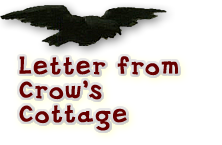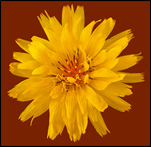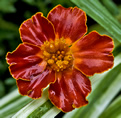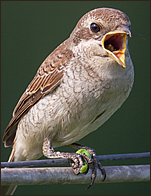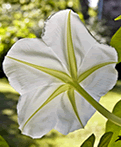
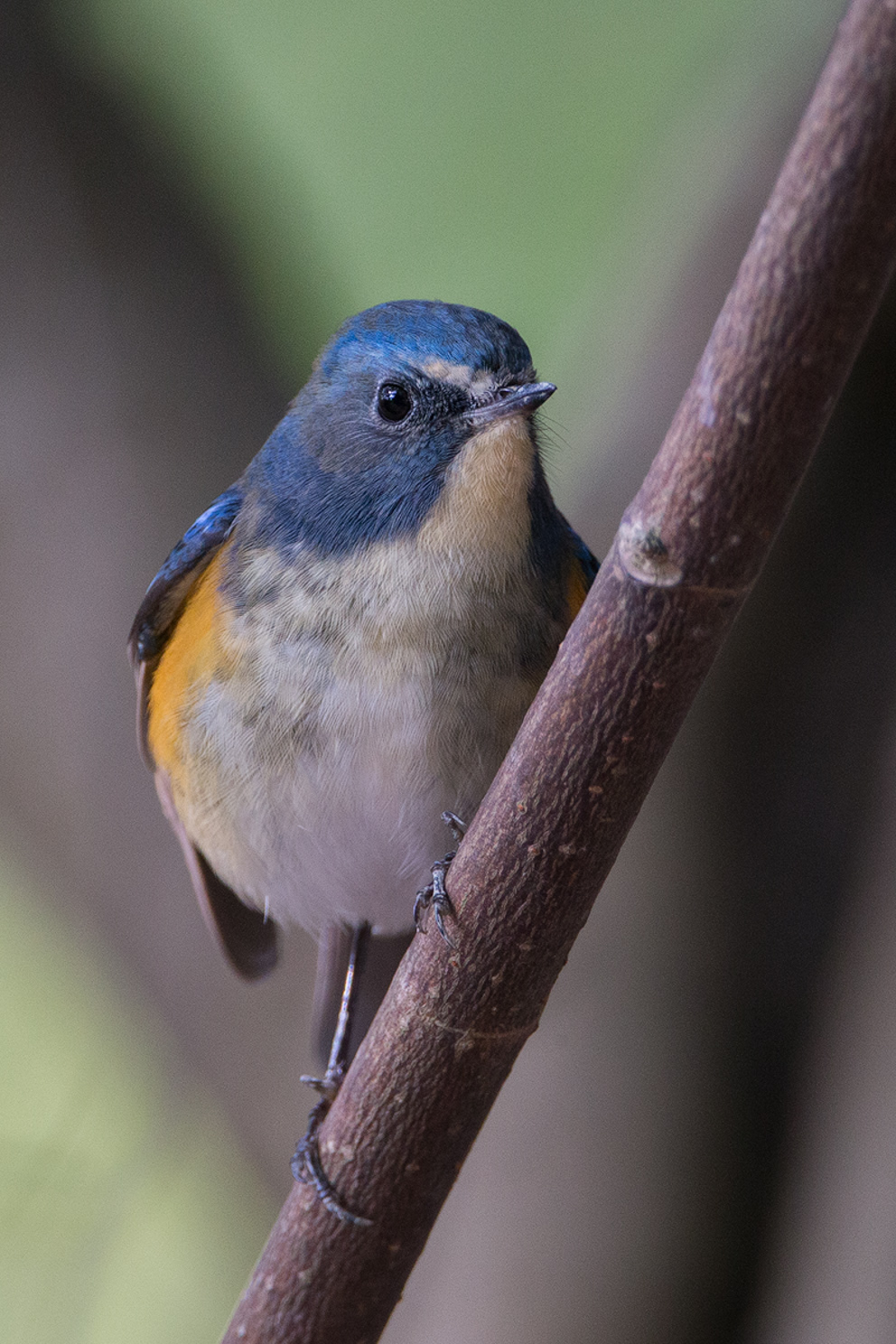
Red-flanked Bluetail Male ∞ Tarsiger cyanurus
Nam Sang Wai, Hong Kong
• 19 December 2013
Photograph by Andrew Hardacre
By Andrew Hardacre
Posted from Hong Kong on 4 February 2014
Tarsiger cyanurus is remarkably stable in taxonomic terms. In Hong Kong we know this species as the Red-flanked Bluetail. If you search in Handbook of the Birds of the World Alive, it is captioned as Orange-flanked Bush-robin. Our vernacular is given second and then Red-flanked Bush-robin, Blue-tailed Robin, Bluestart, and Siberian Bluestart. The advantage of a universal scientific name is thus demonstrated. My (sadly out of date 5th edition) copy of Clements’ Birds of the World, A Checklist, gives three races: the nominate cyanurus, pallidor and rufilatus.
Going back to 1930 I have found only one clear change in genus. At some point it moved from Ianthia to Tarsiger. In Ali & Ripley’s Handbook of the Birds of India and Pakistan, 1983, it is listed as Eastern Redflanked Bush Robin (sic), Erithacus cyanurus rufilatus — but this appears to be an outlier.
In a 1936 publication, HK Naturalist, the (presumably same) species is called The Siberian Blue-tail or Ianthia cyanura.
J. D. D. La Touche in 1930 recorded the terms Siberian Blue-tail and Ianthia cyanura, but he also cites Tarsiger cyanurus — perhaps to bridge this minor shift of the taxonomic tectonic plates.
A 19th Century Perspective
Henry Eeles Dresser leaves us a comprehensive overview of the 19th century perspective of the bird in his A History of the Birds of Europe (1871-1881). He addresses the identification and distribution in some detail. His chapter on what he tagged as Nemura Cyanura reads like a who’s who of contemporary ornithology: Seebohm, Jerdon, von Middendorff, von Schrenck, Radde, Père David, Przevalsky, Swinhoe, Hume, Stoliczka, Hodgson — names that we still honour today.
Dresser also lists no less than nine scientific names for our bird. Six had already adopted cyanura / cyanurus. There were, however, five different versions of the genus from the rather odd Motacilla given by Pallas to the more familiar Ianthia of Swinhoe. Perhaps my assertion of stability is a relatively modern view.
I smiled when I read the conclusion of Dresser’s chapter about the Red-flanked Bluetail. He notes that some authors divide the species into two forms, Nemura cyanura and Nemura rufilata. He debunks this division, but to me it is amusing to discover that even in the late nineteenth century the lumpers and splitters were at it. ‘Armchair ticks’ are not a new invention.
Beyond issues of genus, there is also temporary discord as to the Family. Birdlife International regards it as a member of Muscicapidae (Chats & Old World Flycatchers), as does Clements, whereas the Handbook of the Birds of the World places it in Turdidae. However, it appears that HBW will harmonize its taxonomy with that of Birdlife in due course. Source: HBW: Traditional HBW taxonomy is now used as a base of reference, but in the near future HBW Alive will be linked to the forthcoming HBW and BirdLife International Illustrated Checklist of the Birds of the World.
Mysteries within the Mystery
Mainstream media has also caught wind of the taxonomic discord among birders. Under the headline "Mystery bird: orange-flanked bush-robin, Tarsiger cyanurus," The Guardian of London explores issues of taxonomy and habitat related to "this small Chinese mystery bird" in its science feature Grrlscientist (10 March 2012). "The taxonomy of this species is confusing," the article reads. Indeed! Here's the link: Grrlscientist: Mystery Bird....
The Guardian piece suggests much more ambiguity around the bluetail's placement, vide: “Orange-flanked bush-robin, Tarsiger cyanurus (synonyms, Luscinia cyanura, Nemura cyanura and Ianthia cyanura; protonym, Motacilla Cyanurus), Pallas, 1773, also known as the red-flanked bluetail or sometimes as the white-breasted blue wood-chat….”
Luscinia I can understand, but the protonym Motacilla is a mystery to me. The genus Motacilla is fully recognized today as that of the delightful wagtails. I am equally bewildered by Grrlscientist's statement that “The one thing that appears consistent is that the orange-flanked bush-robin has never been placed into Erithacus” since it is clearly placed there by Ali. The moral of this story is do your own research. Just because it is on the Internet does not necessarily make it true!
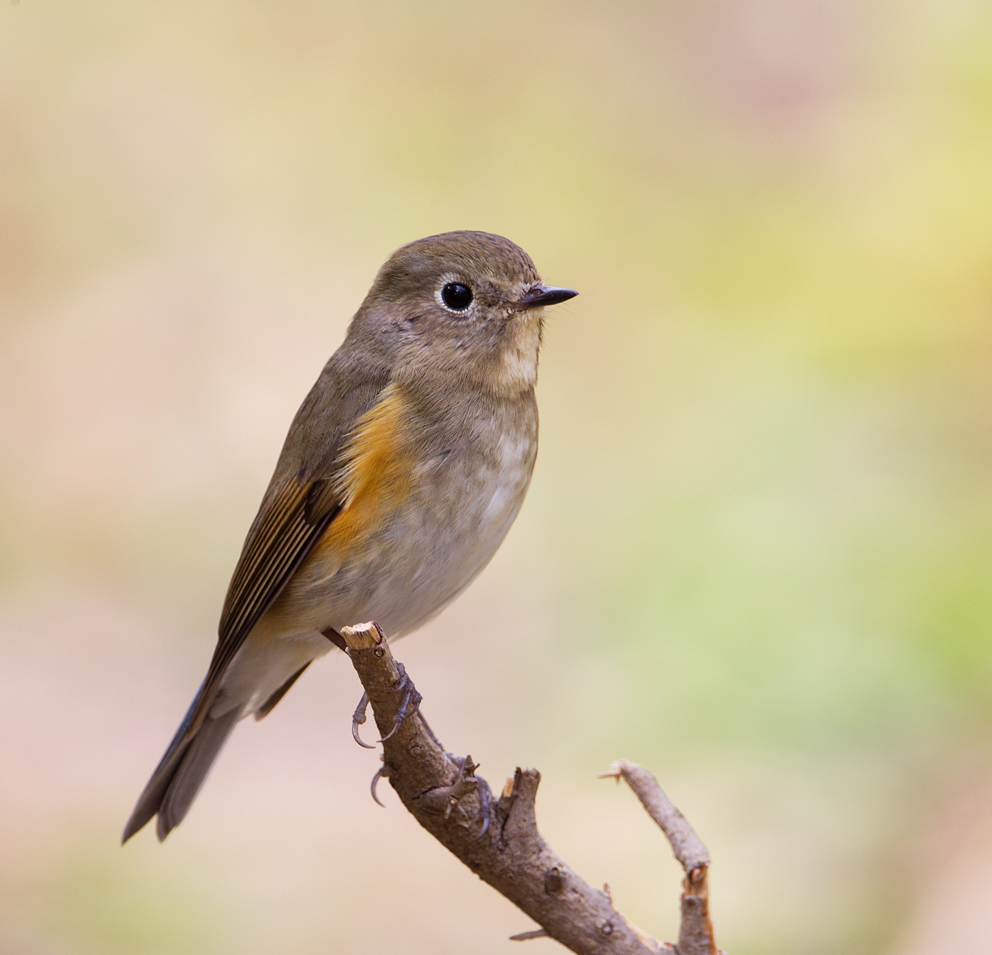
Red-flanked Bluetail Female
Long Valley, Hong Kong
• 24 January 2013
Photograph by Andrew Hardacre
Habitat
Our bluetail is a bird of forests and scrub or shrub. In Hong Kong I have seen it in gardens, at roadsides and on fences. Invariably some sort of cover is available if the bird feels the need to retreat under threat. I tend to see the bird in sparsely copsed areas where, with a little patience, it is possible to get good views and take photographs. It seems to remain loyal to a patch once it has settled. I wouldn’t say it is inquisitive, but its circle of fear is not too wide. It rarely seems to fly far and will return if the observer sits quietly and still for a while. David Tipling, writing in British Birds, January 1994, stated that they can be remarkably tame.
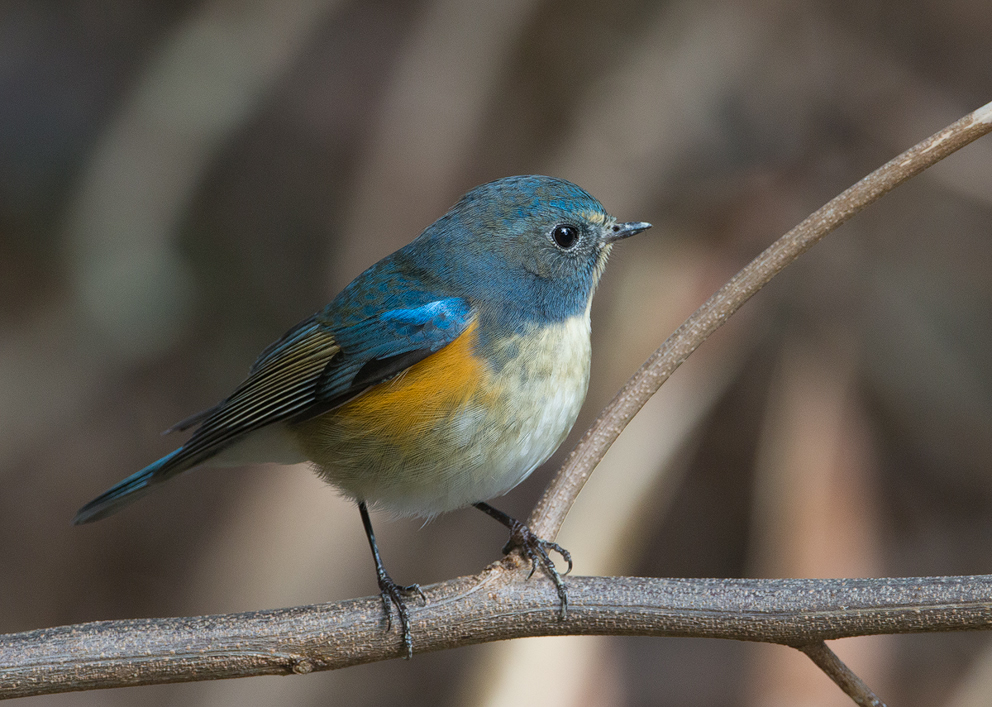
Red-flanked Bluetail Male
Nam Sang Wai, Hong Kong
• 19 December 2013
Photograph by Andrew Hardacre
Status
Our pretty little bluebird is "not globally threatened," according to the Red List of the International Union for Conservation of Nature (IUCN). In Hong Kong it is a common winter visitor and passage migrant.
My first recollection of this species dates back to October and November 1993. I had recently taken up birding as a more serious interest. I remember that a Red-flanked Bluetail was found in Dorset, England, at a place called Winspit. The excitement was immense. This was the 13th British record at the time.
For the bluetail, being number 13 was arguably lucky. The first accepted record of Red-flanked Bluetail appears to have been in October 1947. This was on Whalsay, Shetland. An earlier record dating back to 1903 was also probably this species, but the record was left as a ‘probable’ due to the passage of time between its original occurrence and it eventually coming to light — some 50 years in fact. The difference between the accepted record of Mr. Samuel Bruce and the probable record of Mr. Caton Haigh is that the former procured the bird whilst the latter bemoaned the fact that he ‘had no chance of shooting it.’ Being an avian trailblazer in days of yore was not for the faint-hearted. Indeed, the first Hong Kong record in 1936 was ‘a female shot at Mong Tseng,’ The Avifauna of Hong Kong records.
Nowadays we generally substitute cameras for guns. For which small mercy we are all truly thankful. Especially the Red-flanked Bluetail.
∞
6:00 p.m.
Birds jab at
the evening,
beaks carrying off
day's blue tail.
Sunset tattooed with
weathercocks
props up the half moon's
small boat.
And in the cold fountain
the little snake sings.
— Federico Garcia Lorca, 1923
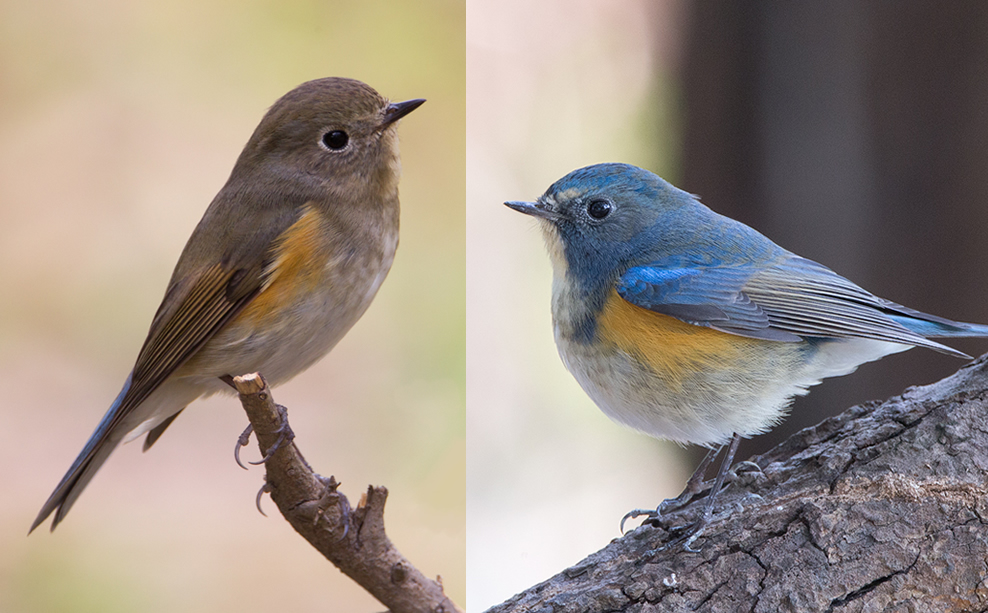
Female and Male
Photographs by Andrew Hardacre
∞
A Resident of the Southerly Islands of Japan
22. TARSIGER CYANURUS.
(Siberian Blue-Tail)
Motacilla cyanurus, Pallas, Reise Russ. Reichs, ii. p. 709 (1776).
The male Siberian Blue-tail is blue above, with a white eye-stripe; and white below with orange-chestnut flanks. The female is olive brown above with no eye-stripe, and in addition to the orange flanks there is an obscure broad brown band across the breast.
Figures: Temminck and Schlegel, Fauna Japonica, Aves, pl. 21 (male and female); David and Oustalet, Ois. Chine, pl. 28 (male).
The Siberian Blue-tail is a summer visitor to Yezzo (Whitely, Ibis, 1867, p. 197); but in the more southerly islands of Japan it is a resident, breeding on the mountains and wintering in the plains. There are twelve examples in the Pryer collection from Yokohama, and Mr. Ringer has sent skins to the Norwich Museum obtained at Nagasaki (Blakiston and Pryer, Trans. As. Soc. Japan, 1882, p. 161). There is an example in the Pryer collection from the central group of the Loo-Choo Islands (Seebohm, Ibis, 1887, p. 174), and another in the Museum of the Smithsonian Institution at Washington from the same locality (Stejneger, Proc. United States Nat. Mus. 1886, p. 646).
The range of the Siberian Blue-tail extends from the Ural Mountains, whence I have seen examples in the Moscow Museum, to Kamtschatka. It is a winter visitor to China and Formosa.
I found this bird in the valley of the Yenesay as far north as the Arctic Circle, and Mr. Jouy describes it as one of the commonest birds in the mountains of Japan during summer, often the only one seen on some of the higher passes. It is very familiar in its ways and easily approached. Seated on a low branch of a tree or shrub, with its head on one side, it utters a low guttural chuckling note (Jouy, Proc. United States Nat. Mus. 1883, p. 281). Mr. Jouy procured examples of this species on Fuji-yama in June and on Tate-yama in December.
T H E B I R D S
Of The
J A P A N E S E E M P I R E
By
H E N R Y S E E B O H M
With Numerous Woodcuts
∞
1890 | LONDON: R. H. Porter, 18 Princes Street, Cavendish Square | pp. 58-59
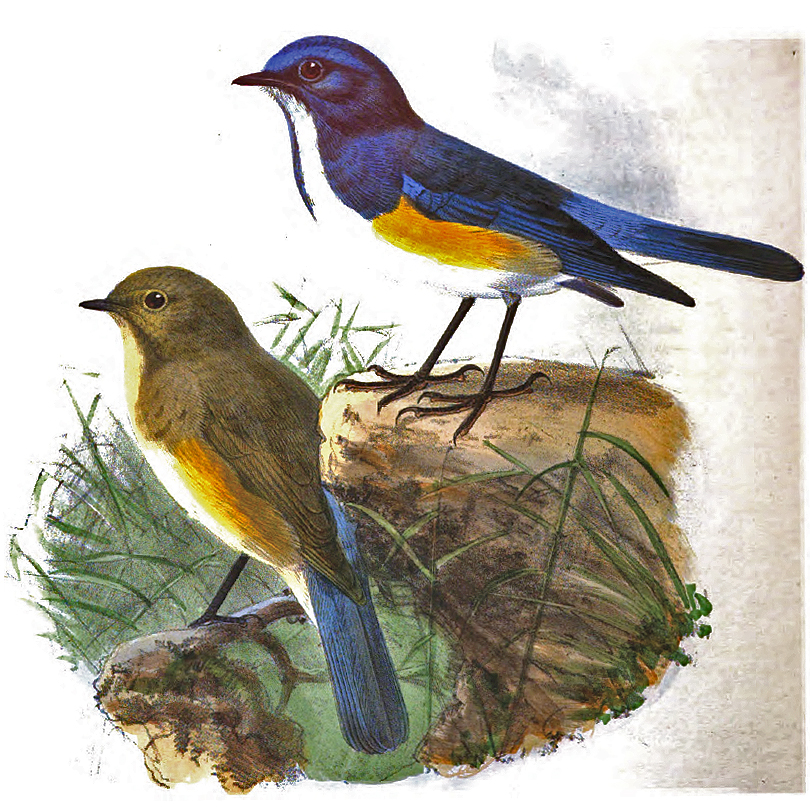
Dresser's Nemura Cyanura
Although depicted under the commonplace name "Redflanked Bluetail,"
the pair illustrated here bears the nomenclature Nemura Cyanura
in Dresser's nineteenth century study of the species.
For context, we refer you to the first segment of this essay —
just in case you missed our analysis of Dresser's text.
What a wonderful lithograph!
∞
Illustration by Johannes Gerardus Keulemans (1842-1912)
Digitized by Google in A History of The Birds of Europe by H. E. Dresser, 1871-1881
∞
A Major Ruffling of Feathers
"After a gale, the helideck of the Hewett was often littered with birds of all shapes and sizes, struggling in the last throes of life or just resting until they had regained sufficient strength to take to the air again. Most of them were starlings, sparrows and finches, with a sprinkling of gulls and in winter perhaps an exhausted greylag goose, but occasionally there was a colorful stranger which no amount of leafing through a bird-identification book could name.
"I once caused a major ruffling of feathers among Norfolk ornithologists by reporting the description of a bird which some throught was a rare red-flanked bluetail, native of Finland, but it stayed only a short time before heading north to tantalize birdwatchers in Yorkshire."
Blowout
∞
Robert Orrell
1989 | London: Seafarer Books | p. 131
Pretty Little Bluebird was posted on Tuesday, February 4, 2014
Largely retired, Andrew Hardacre is an enthusiastic photographer across a wide range of genres, from wildlife to street. He grew up in rural Britain but has traveled the 7 continents in search of birds and photographs. Now settled in rural Hong Kong, he continues to indulge his passion for books, wildlife and photography. Andrew is a Moderator of the Bird Photography community on Google+.
![]() Andrew Hardacre
Andrew Hardacre
You can reach Andrew by e-mail at 57andrew@gmail.com
![]() The IUCN Red List of Threatened Species
The IUCN Red List of Threatened Species
The International Union for Conservation of Nature assesses the conservation status of species, subspecies, and varieties of living things on a global scale to highlight taxa threatened with extinction. The Red List of Threatened Species™ evaluates plants and animals according to seven categories: least concern, near threatened, vulnerable, endangered, critically endangered, extinct in the wild, and extinct. Our pretty little bluebird, Tarsiger Cyanurus, holds the status of least concern and is considered stable.
![]() BirdLife International Data Zone
BirdLife International Data Zone
As our essay illustrates, taxonomy for birds has entered a period of great flux. One organization, BirdLife International, is tracking the "current phase of taxonomic revision" toward the goal of making some sense of it all. The web linked here points to "The Birdlife Checklist," a useful tool for the study of the depth and complexity of taxonomy and classification. The checklist can be downloaded for free.
![]() All downhill from here | Whatever comes to mind.......
All downhill from here | Whatever comes to mind.......
Andrew's blog showcases a wide range of his interests: photographs and commentary inspired by the natural world and the creatures who inhabit it. You'll also find some compelling character studies of our fellow humans.
![]() 57Andrew on flickr
57Andrew on flickr
OK, the editors here at Crow's Cottage are biased in Andrew's favor, but these images are special! If you study the gallery for a while, you'll find our bluetail amongst the flickr flock of beautiful birds. You'll also see world-class photographs of dragonflies, amphibians, insects, moths, dogs, and members of the human family.



